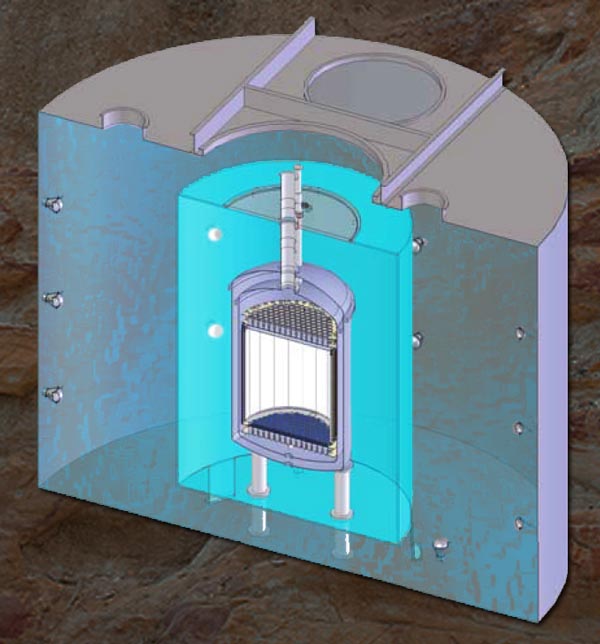
LUX ZEPLIN would be located inside the 72,000-gallon water tank now occupied by LUX in the Sanford Underground Research Facility’s Davis Campus, 4,850 feet below the surface. LZ’s inner vessel will hold seven metric tons of liquid xenon to detect weakly interacting massive particles (WIMPs).
The LUX ZEPLIN (LZ) collaboration has received a major award from the U.S. Department of Energy’s Office of Science to support a year of research and development leading to a second-generation dark-matter experiment. Co‑principal investigators of LUX ZEPLIN are Gil Gilchriese of Berkeley Lab’s Physics Division and Tom Shutt of Case Western Reserve University. Bill Edwards of Physics, who is with the University of California at Berkeley, is the LZ project manager.
The LZ proposal is named for LUX, the Large Underground Xenon experiment, which is poised to begin operation shortly at South Dakota’s Sanford Underground Research Facility, and the smaller ZEPLIN experiments (Zoned Proportional Scintillation in Liquid Noble Gases), which ran until 2011 in the Boulby Underground Laboratory in the United Kingdom. Both experiments were designed to detect WIMPs (weakly interacting massive particles) in vessels containing xenon in both the liquid and gas phases. LUX has been supported principally by DOE and the National Science Foundation and will soon be the world’s most sensitive such detector.
As a second-generation experiment, LZ would carry on and extend the research of LUX and will be located precisely in the space LUX now occupies, inside a 72,000-gallon tank of water in the Sanford Lab’s Davis Campus, 4,850 feet below the surface of the Black Hills. The overlying rock and surrounding water shield against cosmic rays and other background radiation. Where LUX’s inner vessel uses roughly a third of a metric ton of xenon to detect and track WIMPs, LZ will use seven metric tons, to be contained inside the biggest experimental vessel that can be lowered fully assembled through the mine shaft to the Davis Campus.
DOE’s Office of High Energy Physics defines a second-generation experiment as one “with the capability to improve by at least an order of magnitude our current knowledge of physical dark matter parameters” – in other words, searching for the thing itself and meanwhile closing in on its possible properties. Within two years LZ should achieve results 1,000 times better than LUX.
WIMPs are the leading theoretical contender for dark matter particles (axions are another possibility, also never seen). Instead of trying to create them in an accelerator or searching for signs of their annihilation far out in space, LUX and LZ are direct searches. While LUX may catch a WIMP, the far larger and more sensitive LZ has a much better chance. “This award covers the development of a full proposal and conceptual design,” says Gilchriese. “It’s a significant step forward and shows that, with support from both NSF and DOE, LZ is on track.”
More about DOE’s search for dark matter is at: http://science.doe.gov/grants/pdf/SC_FOA_0000597.pdf.
More about LUX and LUX ZEPLIN is at http://newscenter.lbl.gov/feature-stories/2012/05/23/lux-lz/.